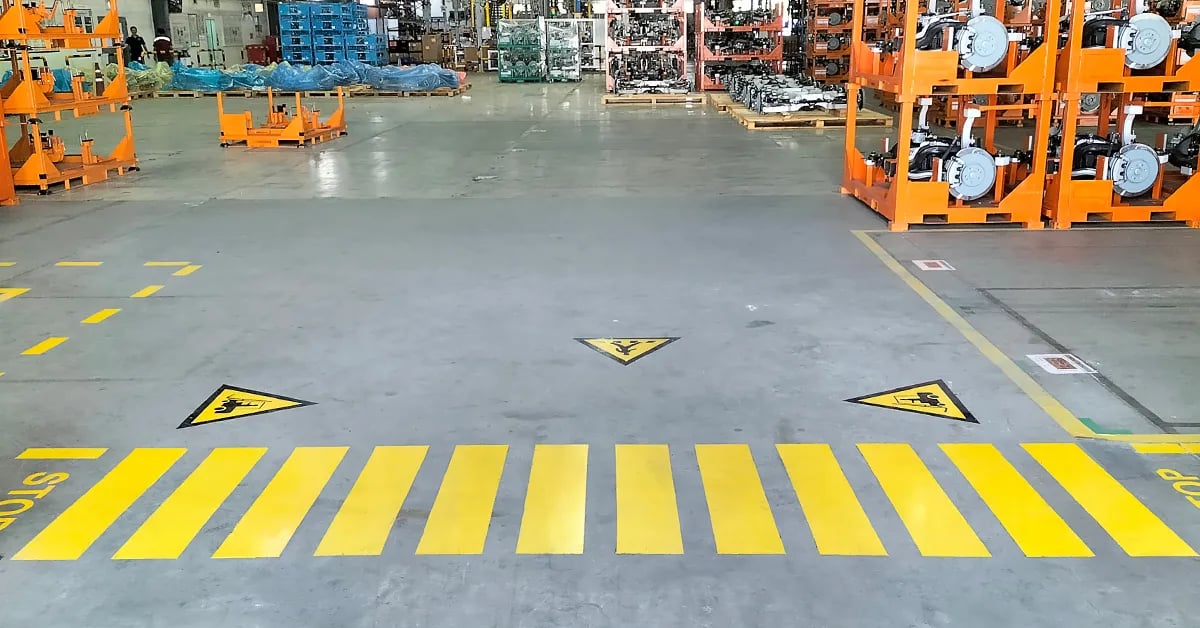In industrial workplaces, safety is paramount, and proper aisle marking plays a crucial role in maintaining a secure environment. The Occupational Safety and Health Administration (OSHA) in the United States has established specific rules and guidelines for industrial aisle marking to help minimize accidents and enhance workplace safety.
In this article, we will explore the importance of aisle marking, delve into OSHA's regulations, and provide practical insights for compliance and implementation.
The Significance of Industrial Aisle Marking for Pedestrian Safety
Pedestrian walkways, when thoughtfully designed, play a pivotal role in enhancing the overall image of a facility, creating a positive impression for employees, customers, and visitors alike. Beyond their functional purpose, aesthetically pleasing walkways contribute to the visual appeal of the surroundings, transforming a mundane path into a welcoming and well-designed space. This attention to aesthetics not only fosters a more pleasant environment for those traversing the area but also sends a positive message about the organization's commitment to a conducive and visually appealing workplace.
Aisle marking is more than just painting lines on the floor; it is an essential component of a well-organized and secure workspace. Properly marked aisles facilitate efficient traffic flow, prevent congestion, reduce the risk of accidents, and help emergency responders navigate in the event of an incident. The key advantages of industrial aisle marking include:
- Safety: Clearly marked aisles help workers and visitors avoid hazards, such as moving machinery or forklifts, and promote a culture of safety within the workplace.
- Organization: Aisles guide the placement of equipment, materials, and personnel, ensuring order and reducing the risk of clutter or obstructions.
- Compliance: Adhering to OSHA's regulations for aisle marking is not only crucial for safety but also for avoiding potential fines and penalties.
OSHA Aisle Marking Requirements
OSHA's regulations for industrial aisle marking are primarily outlined in 29 CFR 1910.22 – Walking-Working Surfaces, and its subpart 1910.176 – Materials Handling and Storage. These regulations stipulate specific requirements for aisle marking to ensure a safe and orderly workplace:
Width and Clearance:
- Aisles must be clear and unobstructed to allow for the safe passage of employees and equipment.
- Minimum aisle width requirements are determined by the type of equipment and the volume of pedestrian traffic in the area. However, OSHA does recommend an aisle width of at least 4 feet. Additionally, OSHA recommends an aisle width that’s at least 3 feet wider than the largest equipment expected to use it.
Marking:
- Aisles should be marked with clearly visible and durable lines, typically using contrasting colors to the floor or background.
- OSHA recommends the use of yellow lines for marking aisles and passageways.
- The suggested range for the width of aisle markings is between 2 inches and 6 inches, making any width equal to or greater than 2 inches acceptable.
Curves and Corners:
- Curved or cornered aisles should be marked with curved lines or dashed lines, respectively, to indicate potential changes in direction.
Crosswalks:
- Where forklifts and pedestrians may cross paths, crosswalks must be marked to alert both parties to the potential hazard.
Pedestrian Walkways:
- Separated pedestrian walkways should be marked with barriers or lines to distinguish them from vehicle traffic areas.
Aisle Intersections:
- At intersections of aisles, there should be clear markings or signage to indicate the right of way and guide traffic.

Implementing Floor & Aisle Marking Requirements from OSHA
To comply with OSHA's rules for industrial aisle marking, employers should consider the following practical implementation tips:
- Assess Your Workspace: Begin by conducting a thorough assessment of your facility's traffic patterns, equipment movement, and pedestrian flow to determine where aisle markings are needed.
- Choose the Right Materials: Invest in durable, high-visibility aisle marking materials that can withstand the wear and tear of daily industrial operations.
- Consistency: Ensure that aisle markings are consistent throughout the facility, using the recommended yellow color and proper signage.
- Maintenance: Regularly inspect and maintain aisle markings to ensure they remain visible and in good condition.
- Employee Training: Train employees on the importance of aisle marking, safe traffic behavior, and the significance of following designated pathways.
- Adaptation: Be ready to adjust aisle markings as needed, especially in response to changes in equipment layout or pedestrian flow.
When it comes to ensuring the safety and compliance of industrial workplaces, consider relying on a company that offers industrial painting services instead of handling the pedestrian aisle marking on your own.
Industrial aisle marking is a fundamental component of workplace safety and organization. By adhering to OSHA's rules and regulations, employers can significantly reduce the risk of accidents and promote a culture of safety within their facilities. Effective aisle marking not only helps protect employees but also ensures compliance with legal requirements, minimizing the potential for costly fines and penalties.








